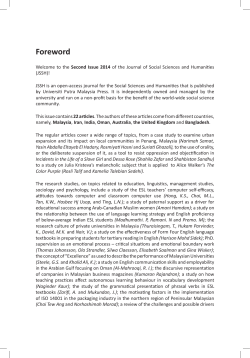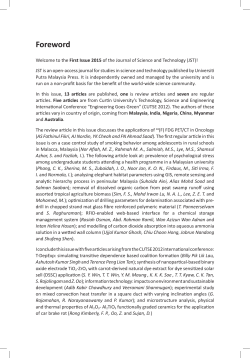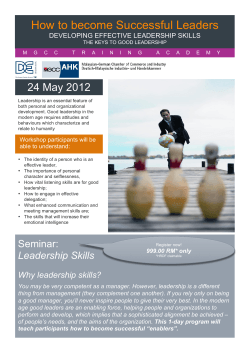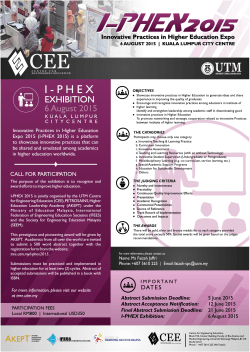
PDF-232K - Journal of Educational Evaluation for Health Professions
J Educ Eval Health Prof 2015, 12: 4 • http://dx.doi.org/10.3352/jeehp.2015.12.4 Open Access eISSN: 1975-5937 Opinion Innovative practices in international partnership: medical undergraduate program in twin campuses of India and Malaysia Ramnarayan Komattil1, Shyamala Hande2* 1Manipal University, Manipal, Karnataka; 2Melaka-Manipal Medical College, Manipal University, Manipal, Karnataka, India Running title: Innovative practices in international partnership *Corresponding email: hande2010@gmail.com Received: September 9, 2014; Accepted: March 9, 2015; Published: March 10, 2015 This article is available from: http://jeehp.org/ © 2015, National Health Personnel Licensing Examination Board of the Republic of Korea. (CC) This is an open-access article distributed under the terms of the Creative Commons Attribution License, which permits unrestricted use, distribution, and reproduction in any medium, provided the original work is properly cited. Melaka-Manipal Medical College has offered a medical undergraduate program in twin campuses of India and Malaysia under the auspices of the Manipal University, Malaysia leading to a Bachelor of Medicine & 1 Bachelor of Surgery degree since 1997. It passed 17 years since its first implementation; therefore, brief opinion on this innovative program is introduced especially on innovative work and the best practice that may be useful model to other countries. Program overview: Students admitted into the program are initially in the Manipal Campus, India. After successfully completing their preclinical studies of two and half year duration, they return to Melaka, Malaysia, for clinical training for two and a half years in Malaysia [1]. The graduates are conferred with an Bachelor of Medicine & Bachelor of Surgery degree, which is accepted by the Malaysian Medical Council and the Malaysian Government. This degree is also accredited by the Malaysian Qualifications Agency. This program of Melaka-Manipal Medical College was launched in September 1997. The program organization was done by a collaborating institute between Joint Venture Medical College Corporation Sdn Bhd, Malaysia and Manipal Education & Medical Group, India. In July 2003, the Government of Malaysia and Malaysian Medical Council recognized the Bachelor of Medicine & Bachelor of Surgery degree of Melaka-Manipal Medical College, which is conferred by Manipal University, Manipal, India [1]. The program predominantly accommodates Malaysian citizens who get an opportunity to reside in India and do their basic science component and initial phase of clinical training in Indian hospitals. This will expose them to the health care delivery and associated practices in Indian settings. The students reside in international hostels which provide housing for students from 50 countries. They also share some common facilities like library, sports and dining area. This has resulted in a milieu that fosters international exposure and promoted cross cultural and interdisciplinary approaches. If students are determined to admit into the program, an orientation program is opened in the home country for new students and their parents. The program is interactive, with question answer sessions and debriefing before the students commence their journey. When they arrive in India, another orientation is done at the College, where the Dean, faculty mentors and senior students attend the program. Help-desks are arranged where the mentor and senior students answer all queries by new students. There are also student-led orientation programs which introduce these students to the academic and social environment, so that the students can become more familiar with the seniors as well as mentors. The mentor is the point of contact in case of any difficulties that the students face. Mentor helps the students to deal with academic difficulties by following up with the students' academic performance and 2 advice accordingly. When students face health problems, the Dean and mentors arrange to provide care and medical services to students at the hospital in the campus. Innovation admitted by accreditation organization: The collaboration between an India and Malaysia with an Indian University awarding the medical degree was the first one of its kind when it was introduced in 1997. This initiative was born out of the need for more health professionals to meet with the mandated requirements of Malaysian administration. The innovation lies in its unique form of delivery happening in two distinct geographic locations. Such programs although rare in Medicine, are not uncommon in Engineering [2]. The basic science component being stronger in the Indian context, students benefit enormously from Indian teachers. However the clinical phase that happens in Malaysia trains them best in their own settings so as to meet the health needs of the Malaysian community. The cross cultural bonding that happens as an offshoot of this program is commendable and needs special mention. The very fact that a dozen other medical schools have started operating in the same fashion is a testimony of the replicable and feasible nature of this innovation. The sustainability of the program is evidenced by an increasing demand from the student community for enrollment in our program. The recent rating of the six-star status by the Malaysian accreditation authorities is the first one of its kind awarded for a private university. MelakaManipal Medical College has emerged as a center of excellence in education as is evident from the five-year accreditation granted to this College by the Malaysian Qualifications Agency (MQA), in 2010, which is the first ever foreign university in Malaysia to have received this honor. The mission of Melaka-Manipal Medical College is to prepare the students in knowledge, skills and attitudes required for the humanitarian and altruistic practice of medicine. This includes the development of an aptitude for lifelong learning, recognizing that medical science is constantly and rapidly expanding and the health needs of communities are constantly changing. Curricular innovation: The curriculum has been planned to provide the best available educational experiences, keeping in mind the overall student development, health needs of the community and accreditation bodies of Malaysia as follows [3]: First, it is a system-based six-strand integrated curriculum introduced in September 2006 with horizontal and vertical strands. Horizontal strands include normal human body & its function, body’s reaction to injury, practice-based medicine, and scientific basis of 3 medicine. Vertical strands include doctor, patient, health, community & environment and personal & professional development. Second, at Manipal Campus, a hybrid approach to the implementation of problem-based learning has been adopted. This provides a cognitive scaffolding of basic sciences in support of clinical studies that students will pursue later. Third, students are given small components of the modules for self-directed learning to motivate independent learning. Fourth, for every admission, students are provided with fully updated colorful brochure which outlines the academic calendar, course requirements, examination rules and campus facilities. Fifth, a booklet outlining the learning objectives in each subject and instructions regarding practices, self-directed learning and examination is provided to students. Sixth, to ensure that students are not only professionally good doctors, but also good human beings, personal and professional development classes are conducted with topics related to doctor-patient relationship, professional ethics and related topics. Seventh, year 2 students of the institution are required to pursue a project involving in-depth study of an area of interest. They also prepare a written, referenced report of scholarly substance. The mentor-guided student project is conducted under the guidance of a faculty mentor. This helps the student to gain an insight into research methodology and to encourage the development of critical thinking skills. Eighth, anatomy pro-section where senior students teach junior students is an enjoyable teaching and learning experience for students. Ninth, students in the clinical semester maintain a portfolio of their learning activities during their posting in various hospitals. Examples of the best practices can be presented in related with students, examination, and faculty developments as follows. Student related practice: Keeping in mind the cultural background and special needs of the international students, a group of students is assigned to a faculty mentor. A mentor functions as a professional counselor, guide and friend. The mentor monitors the progress of his wards and keeps the parents informed. Mentors maintain a profile card for each of their wards as a record of their academic progress. The policy shows that the dean and faculty are accessible to students easily, encourages an open flow of communication and there is better access to information. It creates a better working and learning relationship. Students who have attended all classes for all subjects in the academic year are honored with a certificate of appreciation on the annual day and the institution can boast of a sizable number of students who achieve this feat. 4 Feedback box: Students are free to give their feedback regarding examination and other matters anonymously. Examination related practice: Objective Structured Clinical Examination and Objective Structured Practical Examination are conducted in order to have a objective and uniform assessment. Clinically oriented, restricted response essay questions are part of theory examinations. Continuous assessment of students is through periodic class tests, self-directed learning and problem-based learning evaluations. Students who have scored distinction marks in the university examinations are invited for a distinction viva wherein they must defend their distinction. Students who have scored borderline marks in the university examinations are required to appear for a borderline viva and they will pass only after a satisfactory performance in the viva. External examiners from India and Malaysia are involved in the conduct of the practical and viva examinations. Faculty development: Weekly faculty council meetings are conducted to review and discuss academic matters. Faculty presents research findings and topics of general interest in these meetings. Staff members are greeted on their birthdays with a card in which colleagues write good things about them. Each faculty gets one Saturday of the month as an off day to facilitate research activity as research/library day. After introduction of this innovative measure, the number of publications from the faculty has increased tremendously. Teaching portfolio is compiled by an academic staff member on his/her own major accomplishments and strengths in the area of teaching. All new faculty members are required to attend the workshops conducted by the Department of Medical Education such as teaching-learning, human resource development, student evaluation, learning skills, public speaking, challenges of classroom teaching and conflict management. In addition, a large number of faculties have been trained by Foundation for Advancement in International Medical Education and Research. Impact of the program can be described as follows: As quoted by Karle Hans "Globalization of medicine is increasing, as manifested by the growing number of migrating doctors and cross-border education providers. In addition, new medical schools of dubious quality are proliferation." He also adds that "Only a minority of countries have quality assurance systems based on external evaluation, and most of these use only general criteria for higher education [4]." This program has been evaluated by external accreditation bodies to maintain quality standards. Melaka-Manipal Medical College has earned a reputation 5 in Malaysia for producing high quality medical professionals, and many of our graduates on internship posting are often appointed as 'Head Interns'. The best reflection of our program would be that many of our graduates have been employed overseas in countries such as the United States, United Kingdom, Canada, Singapore, Australia, New Zealand, and the Middle-East. Students are trained in carrying out research and a number of students have already managed to have papers published in journals and so on, which is not usual for undergraduate students. With the affirmative action plans of the Malaysian Government to concentrate on certain sections of population, aspiring doctors from Malaysia are able to pursue medicine. Based on the high standards of medical education of Manipal University, Melaka-Manipal Medical College has set the benchmark of superior medical education in Malaysia, and it has gained an excellent reputation, being awarded a Superbrand in Medical education by the Institute of Superbrands South-East Asia. In conclusion, undergraduate medical education, as with any other educational program, needs ongoing improvements to meet the changing demands of medical practice in the world today. Manipal Campus of Melaka-Manipal Medical College has persistently been driven by the objective of ensuring the best quality of education for its students and the best possible working environment for the faculty. ORCID Ramnarayan Komattil: http://orcid.org/0000-0002-7117-1830 Shyamala Hande: http://orcid.org/0000-0002-0837-1266 CONFLICT OF INTEREST No potential conflict of interest relevant to this article was reported. SUPPLEMENTARY MATERIALS 6 Audio recording of abstract ACKNOWLEDGMENTS The authors are indebted to Manipal University, Faculty of Melaka-Manipal Medical College, Manipal and Melaka Campuses for the inputs on best practices and program outcomes. REFERENCES 1. Melaka-Manipal Medical College, Manipal Campus [Internet]. [cited 2014 September]. Available from: http://www.manipal.edu/institutions/medicine/mmmcmanipal/pages/welcome.aspx 2. Felder RM. Brent R, Prince MJ. Engineering instructional development: programs, best practices, and recommendations. J Eng Educ. 2011;100:89–122. http://dx.doi.org/10.1002/j.2168-9830.2011.tb00005.x 3. Kern DE, Thomas PA, Howard DM, Bass EB. Curriculum development for medical education: a six-step approach. Baltimore: Johns Hopkins Press; 1998. 4.Karle H. Global standards and accreditation in medical education: a view from the WFME. Acad Med. 2006;81:S43-8. http://dx.doi.org/10.1097/01.acm.0000243383.71047.c4 7
© Copyright 2025















